Garmin Forerunner 165 Reviewed: a Little Watch That Does a Lot
March 06, 2024BruceDayneHeading out the door? Read this article on the new Outside+ app available now on iOS devices for members! Download the app.
Pricing and determining features on smartwatches for a brand like Garmin must be hard. You’ve got countless lines and models of watches for specific types of users—runners, triathletes, general health and wellness, outdoor/hiking, military, and so on. I’d imagine there’s a pretty intricate dance that goes on behind the scenes when a new model smartwatch comes out: You want to price a watch so that people will buy it, but you don’t want to price it close enough to another watch in the Garmin ecosystem that it basically kills another model. And of course you don’t want two watches so similar that one becomes superfluous.
It’s with this context in mind that I wanted to review a Garmin smartwatch that is packed with features, at a great price and AMOLED touchscreen, that ticks all of the boxes for what a runner would want—really at almost any level.
Section dividerGarmin Forerunner 165 Review: The Basics
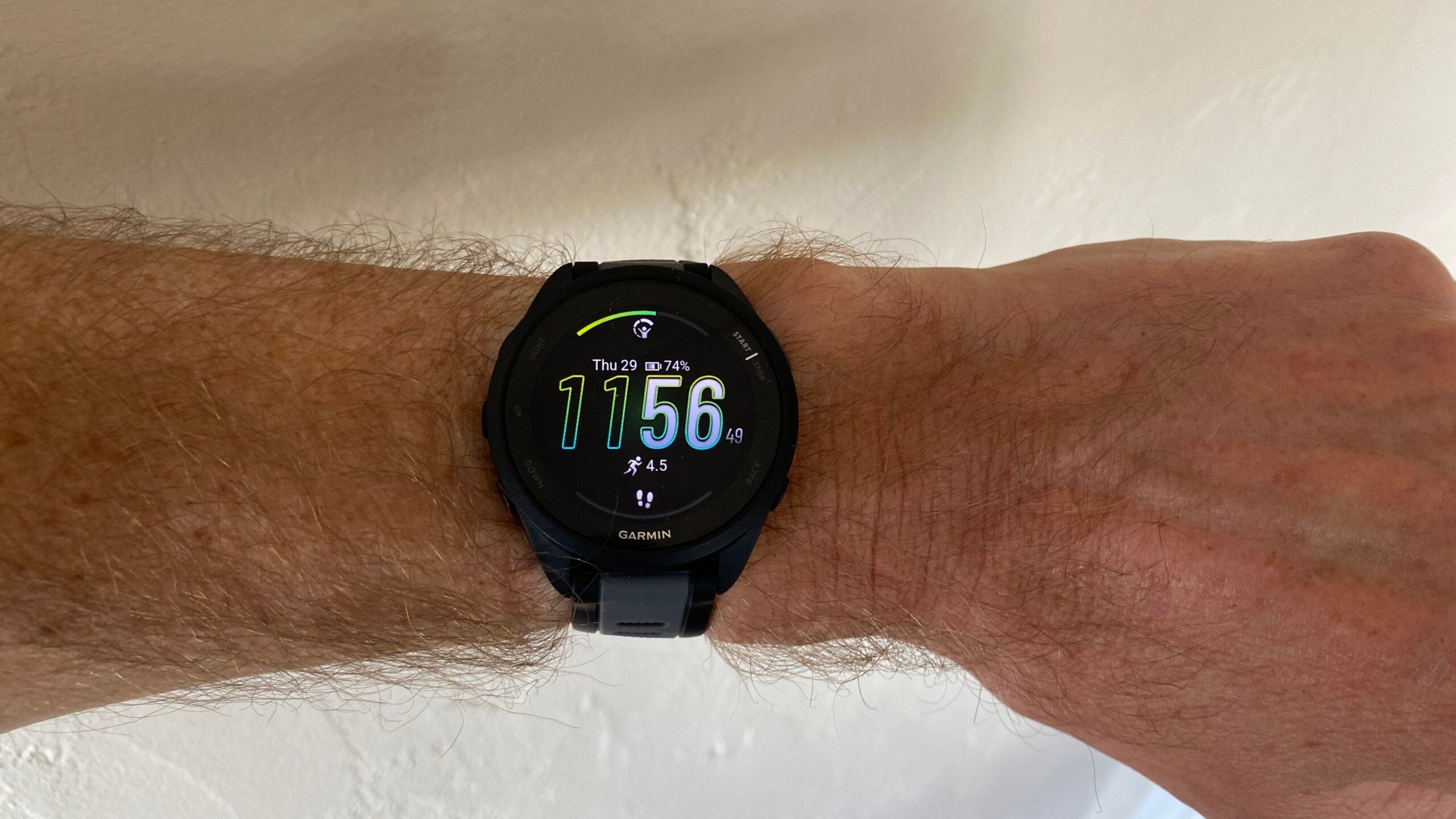
As the Forerunner 1xx line is technically brand-new — ostensibly replacing the 0xx line, including the Forerunner 45 and 55 — it’s a little tougher than simply listing the new features. And since this is Garmin’s first budget-friendly (i.e., under $450) endurance-focused smartwatch with a bright, beautiful AMOLED screen, it’s worth giving a proper introduction.
This is a pretty packed watch, in terms of features, but I’ll start with the big highlights and then move down into the more nitty-gritty details:
First, it’s worth noting that this is the least-expensive Garmin that boasts the open-water swimming activity—same goes for on-wrist running with power. This is also Garmin’s least expensive (by a bit) AMOLED touchscreen watch that’s truly focused on endurance sports, a title taken away from the surprisingly expensive Forerunner 265 ($450).
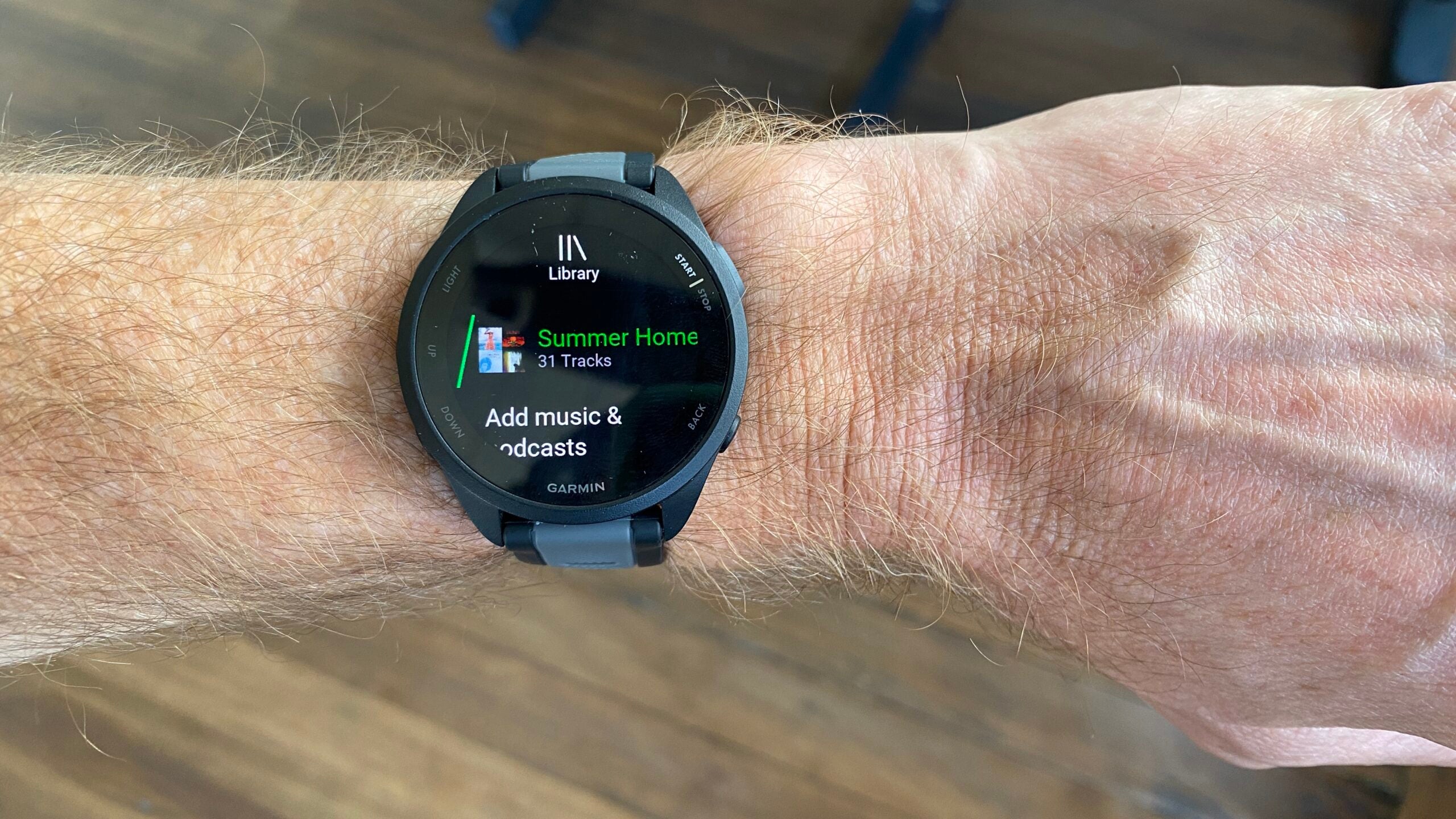
The Music version of the 165 (that runs $300) also has 4GB of storage to load onboard music—from .mp3s or services like Spotify, Amazon Music, or Deezer. The streaming music feature is actually pretty helpful, as very few people still have actual .mp3 files.
The Forerunner 165 also does a host of training features like daily suggested workouts, coaching for a handful of running distances, “PacePro” to help you properly pace runs and races based on goals and terrain, and more.
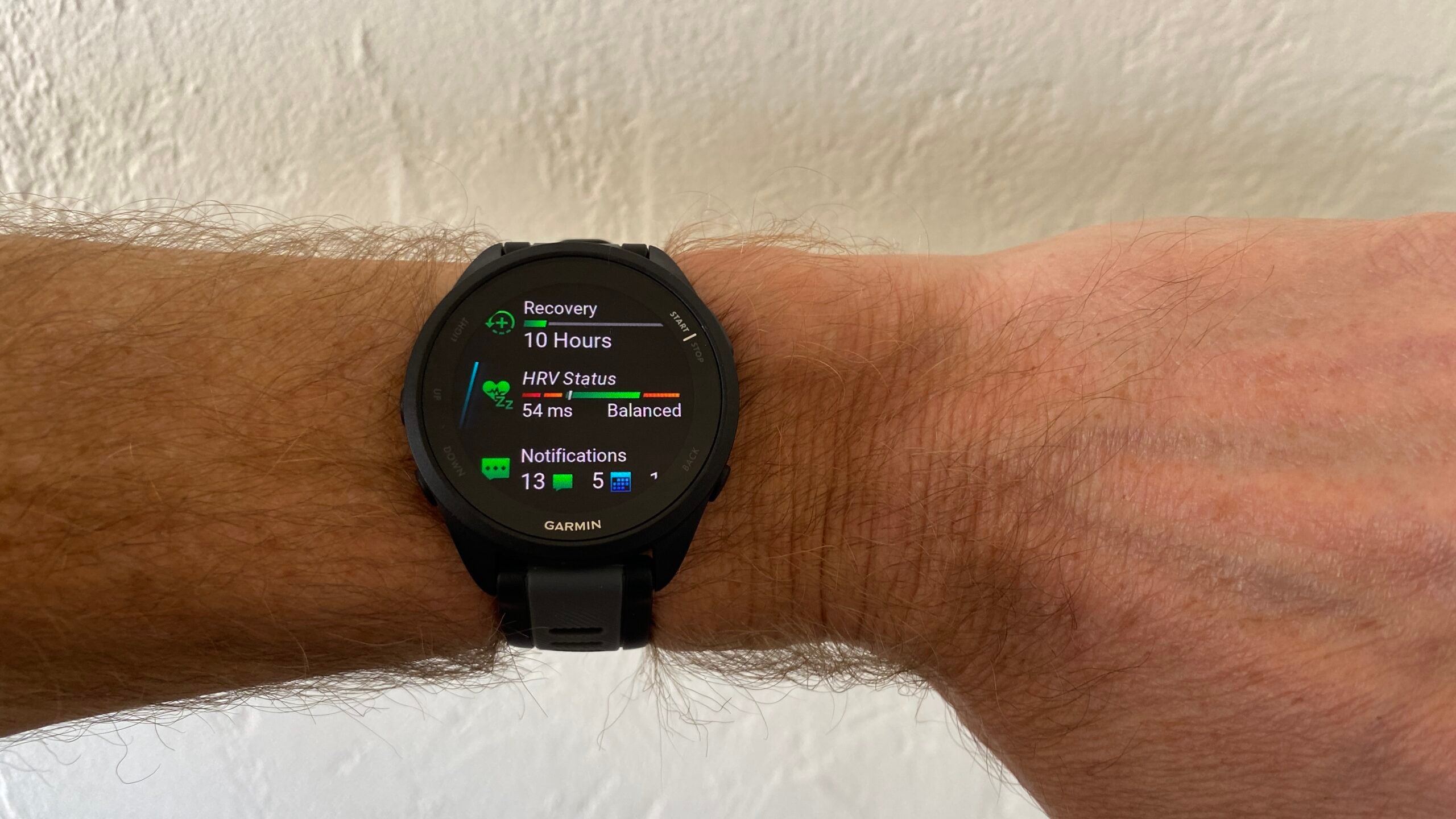
In terms of physio tracking, the 165 has a surprisingly robust suite that includes a pulse ox sensor, heart-rate variability (HRV) tracking, stress tracking, “intensity minutes” tracking, onboard heart-rate tracking, sleep monitoring, recovery metrics, women’s health tracking, and more.
Finally, the nitty-gritty details for the Forerunner 165 include a 1.2-inch color 800 nit-max AMOLED touchscreen, with an advertised 11 days of everyday smartwatch battery life (17 hours of all-on GPS)—though I found in real life testing that I got more like 7 days with daily training—and even a barometric altimeter, which is helpful for accurate elevation gain readings.
Section dividerGarmin Forerunner 165 Review: The Good
If you’ve come this far in the review, you already know there’s a ton of great, high-end features on this $250 watch, so it really strikes the bang-for-your-buck department—something that Garmin traditionally has been a little “off” with. There’s no other endurance-focused smartwatch on the market that has an AMOLED screen at this pricepoint, so if that super-colorful, high-resolution display is important to you, this is where you get on.
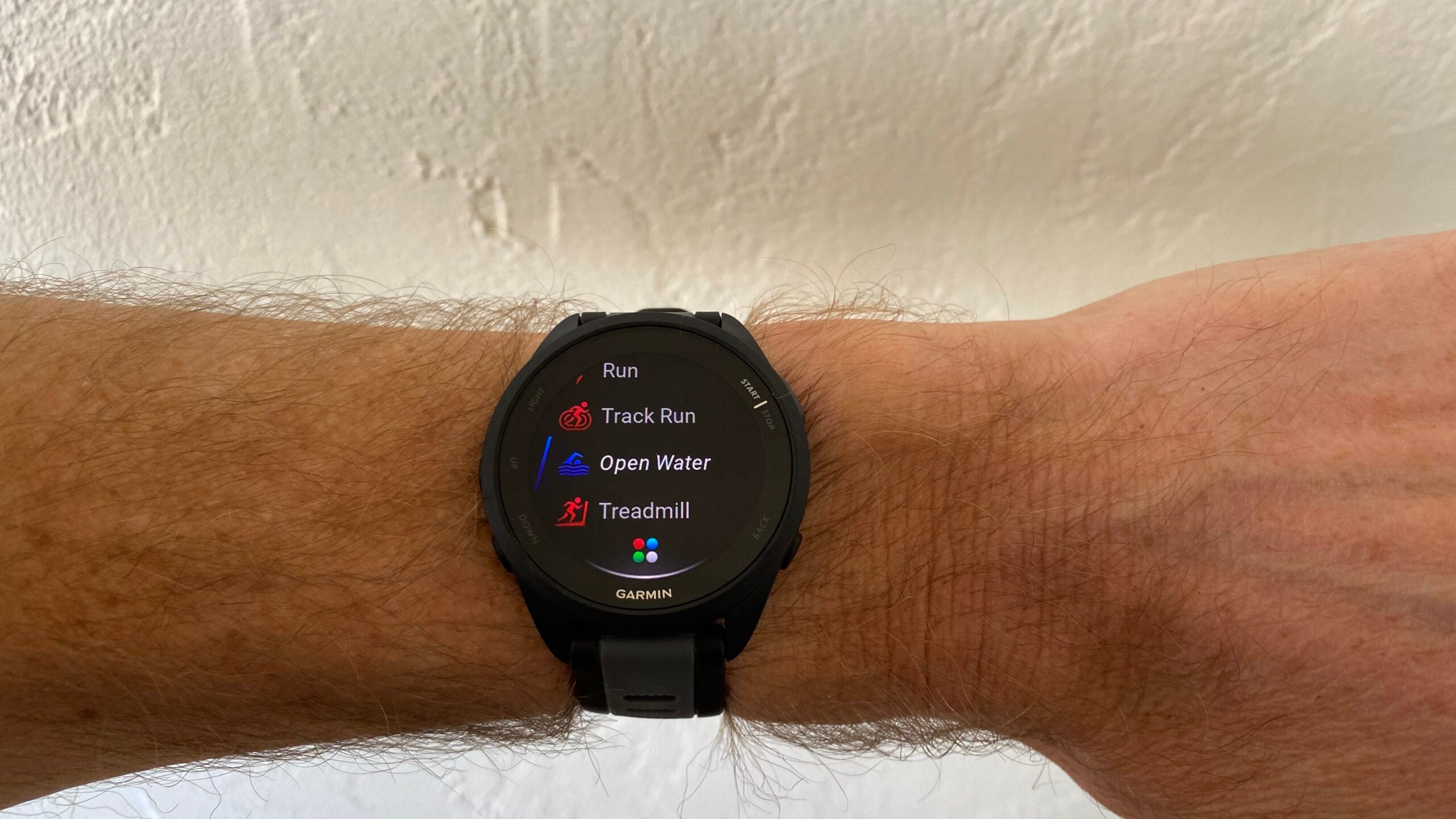
Furthermore, there aren’t a ton of watches in the sub-$300 range that do running with power: The Polar Pacer covers running with power, as does the Apple Watch SE (but is woefully outmatched in battery life); and the Coros Pace 3 hits this too, but doesn’t have an AMOLED touchscreen.
I also really liked the small footprint and light weight (40g measured) of this watch. The band itself is one of the most narrow I’ve ever seen on a smartwatch. If you have a petite wrist and have struggled with beefy bands, this is a great option that marries with an appropriately sized screen.
The raise-to-wake function on the screen—something that Garmin’s Forerunner 965 oddly struggled with, initially—is very crisp and posed no problems, unlike the “sticky” Polar Vantage V3. I also found the 165 to get between 5-7 days of real-world use with training, a figure that might not seem amazing compared to other non-AMOLED watches, but is just about on par for these bright, processor-intensive screens. For comparison, the Forerunner 265 had about 7-10 days of real-life use and the Polar Vantage V3 had even less than that—bearing in mind that both have very active AMOLED screens.
Section dividerGarmin Forerunner 165 Review: The Not-So-Good
If you’re a multi-sport athlete, the Garmin Forerunner does not have triathlon, multisport, duathlon, or swimrun activities. There is no way (that I found) to switch sports within one activity. It’s possible that this is intentional—so as not to hurt the Forerunner 265—or it could be some sort of internal hardware limitation. That said, it doesn’t mean you can’t race a triathlon, start with the open-water swim activity, end it as you enter transition, start a cycling activity (assuming you don’t use power), end it, then do a run as you leave the transition area. You’ll have all of the data you need, with the exception of your transition times—which races typically provide anyway.
Other than that, this is a tough watch to criticize at this price. Sure it has breadcrumb navigation only (so no mapping), but it syncs up with Garmin’s excellent courses feature on the Garmin Connect smartphone app, and no watches have onboard mapping in this price range. It also doesn’t have multi-band GPS, which some watches in this range have (the Coros Pace 3, for instance), but I found the all-on GPS to be very accurate, even in deep canyons and forests.
Section dividerConclusions
This is a great watch for a vast slice of runners. Even for multi-sport athletes, I’d be surprised if the lack of a triathlon/multisport/etc. mode was something that really became a dealbreaker, given the very easy ways to get around the limitation. The screen is fantastic, it’s responsive, and it has a wall of useful features—leaving behind some of the more deep-dive functions that probably only 1% of triathletes would ever use anyway.
As I picked this watch apart, comparing its functions to its competitors and to other watches in the Garmin line—which, we can all admit are not always “budget friendly”—I really struggled to find any reason not to buy this watch if you had $300 burning a hole in your pocket. When you combine the black-and-white features and functions, along with the huge ecosystem of Garmin’s apps and services, along with the fact that it’s a nice-looking watch that actually does what it advertises on the spec sheet, this could be one of the best bang-for-your-buck smartwatches on the market at the moment.
Section dividerCompetitive Comparison: Garmin Forerunner 165 vs. Coros Pace 3 vs. Polar Pacer vs. Wahoo Rival vs. Apple Watch SE
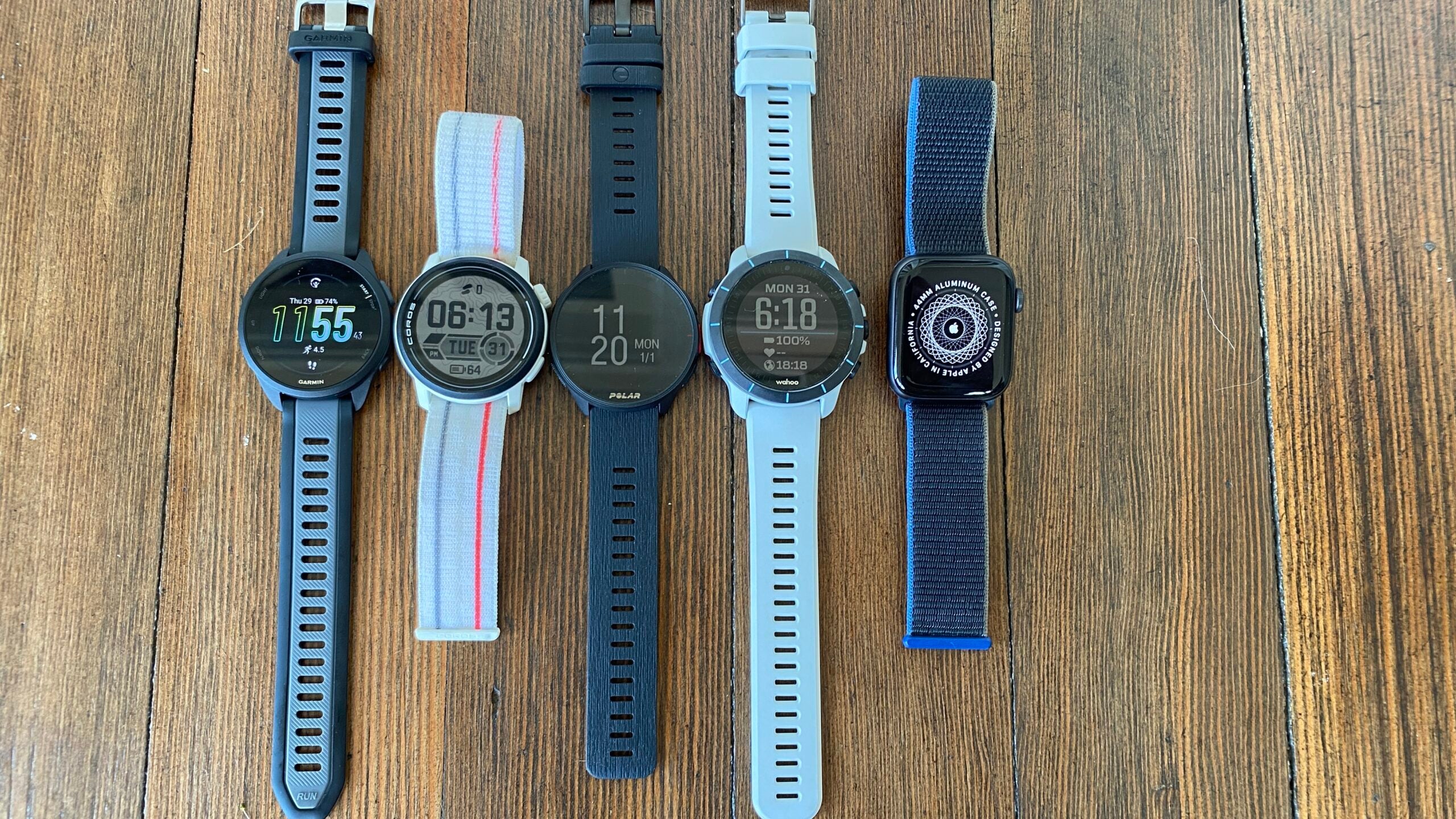
How does the Garmin Forerunner 165 stack up against other smartwatches in its price range? Refer to the below table for a side-by-side comparison, or read our hands-on reviews of the Coros Pace 3, Polar Pacer, Wahoo Rival, and Apple Watch SE.
RELATED: The Best Triathlon Smartwatches, Reviewed
| Garmin Forerunner 165 | Coros Pace 3 | Polar Racer | Wahoo Rival | Apple Watch SE | |
| Price | $250 | $230 | $201 | $200 | $250 |
| Weight | 40g | 30g | 40g | 54g | 45g |
| Touchscreen | 30.4mm AMOLED, 390x390 | 30.4mm 64-color, 240x240 | No | No | 39mm OLED, 324x394 |
| Battery Life | 11 days smartwatch, 17 hours GPS | 17 days smartwatch, 39 hours GPS | 6 days smartwatch, 35 hours GPS | 14 days smartwatch, 24 hours GPS | 18 hours smartwatch |
| Real-World Battery Life (w/ workouts) | 5-7 days | 15+ days | 5-6 days | 8-12 days | 12-14 hours |
| Open-Water Swimming | Yes | Yes | Yes | Yes | Yes |
| Cycling With Power Connectivity | No | Yes | No | Yes | Yes |
| Running With Power | Built-In | Built-In | No | No | Built-In |
| Triathlon Mode | No | Yes | Yes | Yes, Auto-Transition | Yes |
| Brick Mode | No | Yes | Yes | Yes, Auto-Transition | Yes |
| Offline Mapping/Navigation | No | No | No | No | No |
| Onboard Music | Yes | Yes | No | No | Yes |
| Third-Party Apps | Yes | No | No | No | Yes |
DMTBeautySpot
via https://dmtbeautyspot.com
mmitchell, DMT.NEWS, DMT BeautySpot,


0 comments